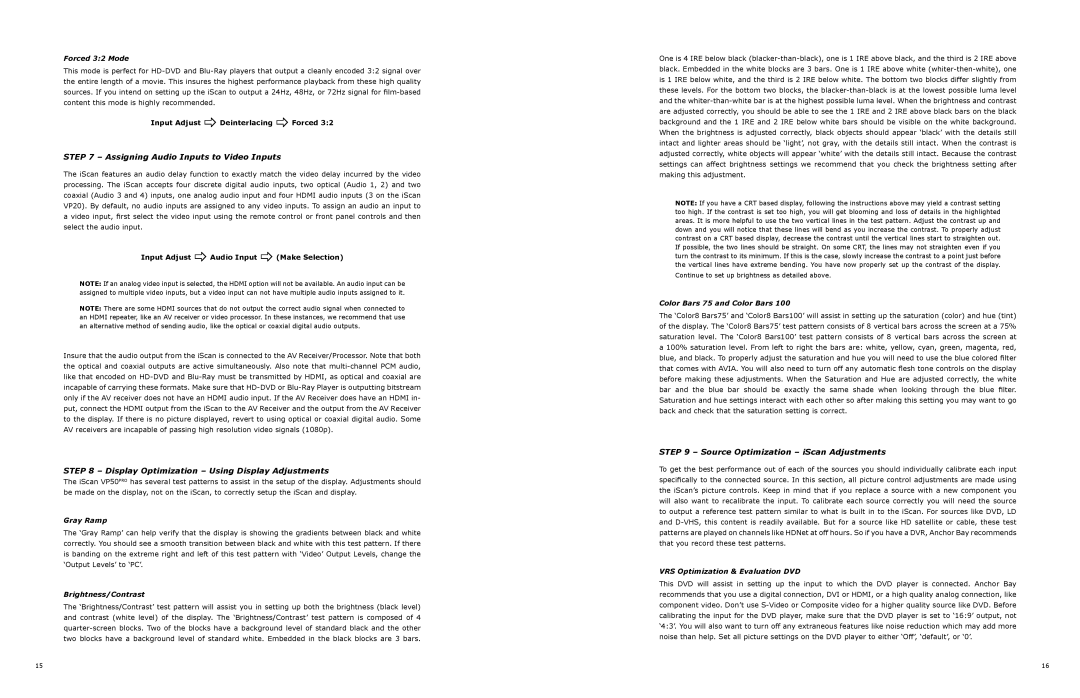Forced 3:2 Mode
This mode is perfect for
Input Adjust _Deinterlacing _Forced 3:2
STEP 7 – Assigning Audio Inputs to Video Inputs
The iScan features an audio delay function to exactly match the video delay incurred by the video processing. The iScan accepts four discrete digital audio inputs, two optical (Audio 1, 2) and two coaxial (Audio 3 and 4) inputs, one analog audio input and four HDMI audio inputs (3 on the iScan VP20). By default, no audio inputs are assigned to any video inputs. To assign an audio an input to a video input, first select the video input using the remote control or front panel controls and then select the audio input.
Input Adjust _Audio Input _(Make Selection)
NOTE: If an analog video input is selected, the HDMI option will not be available. An audio input can be assigned to multiple video inputs, but a video input can not have multiple audio inputs assigned to it.
NOTE: There are some HDMI sources that do not output the correct audio signal when connected to an HDMI repeater, like an AV receiver or video processor. In these instances, we recommend that use an alternative method of sending audio, like the optical or coaxial digital audio outputs.
Insure that the audio output from the iScan is connected to the AV Receiver/Processor. Note that both the optical and coaxial outputs are active simultaneously. Also note that
STEP 8 – Display Optimization – Using Display Adjustments
The iScan VP50PRO has several test patterns to assist in the setup of the display. Adjustments should be made on the display, not on the iScan, to correctly setup the iScan and display.
Gray Ramp
The ‘Gray Ramp’ can help verify that the display is showing the gradients between black and white correctly. You should see a smooth transition between black and white with this test pattern. If there is banding on the extreme right and left of this test pattern with ‘Video’ Output Levels, change the ‘Output Levels’ to ‘PC’.
Brightness/Contrast
The ‘Brightness/Contrast’ test pattern will assist you in setting up both the brightness (black level) and contrast (white level) of the display. The ‘Brightness/Contrast’ test pattern is composed of 4
One is 4 IRE below black
NOTE: If you have a CRT based display, following the instructions above may yield a contrast setting too high. If the contrast is set too high, you will get blooming and loss of details in the highlighted areas. It is more helpful to use the two vertical lines in the test pattern. Adjust the contrast up and down and you will notice that these lines will bend as you increase the contrast. To properly adjust contrast on a CRT based display, decrease the contrast until the vertical lines start to straighten out. If possible, the two lines should be straight. On some CRT, the lines may not straighten even if you turn the contrast to its minimum. If this is the case, slowly increase the contrast to a point just before the vertical lines have extreme bending. You have now properly set up the contrast of the display.
Continue to set up brightness as detailed above.
Color Bars 75 and Color Bars 100
The ‘Color8 Bars75’ and ‘Color8 Bars100’ will assist in setting up the saturation (color) and hue (tint) of the display. The ‘Color8 Bars75’ test pattern consists of 8 vertical bars across the screen at a 75% saturation level. The ‘Color8 Bars100’ test pattern consists of 8 vertical bars across the screen at a 100% saturation level. From left to right the bars are: white, yellow, cyan, green, magenta, red, blue, and black. To properly adjust the saturation and hue you will need to use the blue colored filter that comes with AVIA. You will also need to turn off any automatic flesh tone controls on the display before making these adjustments. When the Saturation and Hue are adjusted correctly, the white bar and the blue bar should be exactly the same shade when looking through the blue filter. Saturation and hue settings interact with each other so after making this setting you may want to go back and check that the saturation setting is correct.
STEP 9 – Source Optimization – iScan Adjustments
To get the best performance out of each of the sources you should individually calibrate each input specifically to the connected source. In this section, all picture control adjustments are made using the iScan’s picture controls. Keep in mind that if you replace a source with a new component you will also want to recalibrate the input. To calibrate each source correctly you will need the source to output a reference test pattern similar to what is built in to the iScan. For sources like DVD, LD and
VRS Optimization & Evaluation DVD
This DVD will assist in setting up the input to which the DVD player is connected. Anchor Bay recommends that you use a digital connection, DVI or HDMI, or a high quality analog connection, like component video. Don’t use
15 | 16 |
